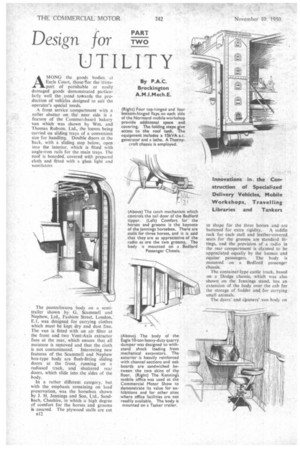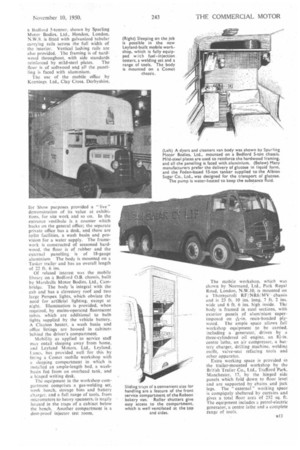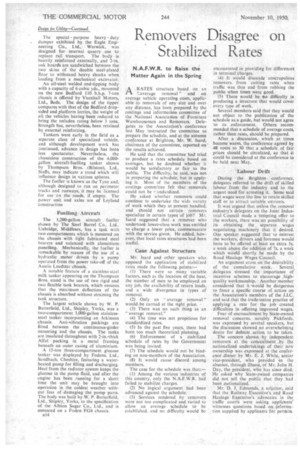Design for
Page 46

Page 47

Page 48

If you've noticed an error in this article please click here to report it so we can fix it.
UTILITY
AMONG the goods bodies at Earls Court, thoselor the transport of perishable or easily damaged goods demonstrated particularly well the trend towards the production of vehicles designed to suit the operator's special needs.
A front service compartment with a roller shutter on the near side is a feature of the Commer-based bakery van which was shown by Wm. and Thomas Robson, Ltd., the loaves being carried on sliding trays of a convenient size for handling. Double doors at the back, with a sliding step below, open into the interior, which is fitted with angle-iron rails for the main trays. The roof is boarded, covered with prepared cloth and fitted with a glass light and vent ilators The pantechnicon body on a semitrailer shown by G. Scammell and Nephew, Ltd., Fashion Street, London, El, was designed for carrying clothes which must be kept dry and dust free. The van is fitted with an air filter at the front and two Vent-Axia extractor fans at the rear, which ensure that all moisture is removed and that the cloth is not contaminated. Interesting new features of the Scammell and Nephew box-type body are flush-fitting sliding doors at the front, running on a radiused track, and shuttered rear doors, which slide into the sides of the body.
In a rather different category, but with the emphasis remaining on load preservation, was the horsebox shown by J. H. Jennings and Son, Ltd., Sandbach, Cheshire, in which a high degree of comfort for the horses and grooms is assured. The plywood stalls are cut
n12 to shape for the three horses and are battened for extra rigidity. A saddle rack for each stall and leather-covered seats for the grooms are standard fittings, and the provision of a radio in the rear compartment is claimed to be appreciated equally by the human and equine passengers. The body is mounted on a Bedford passenger chassis. .
The containet-lype cattle truck, based on a Dodge chassis, which was also shown on the Jennings stand, has an extension of the body over the cab for the storage of fodder and for carrying small animals.
The dyers' and cleaners' van body on a Bedford 5-tonner, shown by Spading Motor Bodies, Ltd., Hendon, London, N.W.9. is fitted with galvanized tubular carrying rails across the full width of the interior. Vertical lashing rails are also provided. The framing is of harcl wood throughout, with side standards reinforced by mild-steel plates. The floor is of softwood and all the panelling is faced with aluminium.
The use of the mobile office by Kennings Ltd„ Clay Cross, Derbyshire, for Show purposes provided a " live" demonstration of its value at exhibitions, for site work and so on. In the entrance vestibule is a counter which backs on the general office; the separate private office has a desk, and there are toilet facilities, a wash basin and provision for a water supply. The framework is constructed of seasoned hardwood, the floor is of rubber and the external panelling is of 18-gauge aluminium The body is mounted on a Tacker trailer and has an overall length of 22 ft. 6 ins.
Of related interest was the mobile library on a Bedford O.B. chassis, built by Marshal's Motor Bodies, Ltd., Cambridge. The body 'is integral with the cab and has a clerestory roof and two large Perspex lights, which obviate the need for artificial lighting, except at night. Illumination is provided, when required, by mains-operated fluorescent tubes. which are additional to bulb lights supplied by the vehicle battery. A Clayton heater, a wash basin and office fittings are housed in cabinets behind the driver's compartment.
Mobility as applied to service staff may entail sleeping away from home, and Leyland Motors, Ltd., Leyland, lanes, has provided well for this by fitting a Comet mobile workshop with a sleeping compartment in which is installed an ample-length bed, a washbasin fed from an overhead . tank, and a hinged writing desk.
The equipment in the workshop cornpartment comprises a gas-welding set, work bench, storage bins and battery charger, and a full range of tools, from micrometers to heavy spannersjs neatly housed in the traps of a cabinet below the bench, Another compartment is a dust-proof injector test room. The mobile workshop, which was shown by Normand, Ltd., Park Royal Road, London, N.W.10, is mounted on a 1 hornycroft RF/ N R6/ M V • chassis and is 23 ft. 10 ins. long, 7 ft. 2 ins. wide and 6 ft. 6 ins, high inside. The body is framed in steel sections, with exterior panels of aluminium super
imposed on resin-bonded plywood. The ample space allows full workshop equipment to be carried, including a generator, driven by a three-cylindered oil engine, an 8,1-in, centre lathe, an air compressor, a battery charger, drilling machine, weldine outfit, valve-seat refacing tools and other apparatus.
Extra working space is provided in the trailer-mounted workshop by the British Trailer Co., Ltd., Trafford Park, Manchester, 17, by the hinged side panels which fold down to floor level and are supported by chains and jack legs. The " external " working space is completely sheltered by curtains and gives a total floor area of 232 sq. ft. The equipment includes a petrol-electric generator, a centre lathe and a complete range of tools.
Design for Utility—Continued.
The special purpose heavy duty dumper exhibited by the Eagle Engineering Co., Ltd., Warwick, was designed for internal quarry use to replace rail transport. The body is heavily reinforced externally, and 2-in. oak boards are sandwiched between the two skins of the double steel-plated floor to withstand heavy shocks when loading from a mechanical excavator.
An all-steel welded end-tipping body with a capacity of 6 cubic yds., mounted on the new Bedford 110 b.h.p. 7-ton chassis is offered by Vauxhall Motors, Ltd., Beds. The design of the tipper compares with that of the Bedford dropsided and platform lorries, the weight of all the vehicles having been reduced to bring the unladen rating below 3 tons. Strength has, nevertheless, been retained by external reinforcing.
Tankers were early in the field as a separate class of specialized vehicle, and although development work has continued, advance in design has been less spectacular. Nevertheless, the chassisless construction of the 4,000gallon aircraft-fuelling tanker shown by Thompson Bros. (Bilston), Ltd., Staffs, may indicate a trend which will influence design in various spheres.
The Netter is known as the Tyne and, although designed to run on perimeter tracks and runways, it may be licensed for use cn the roads, if empty. The power unit and axles are of Leyland construction Fuelling Aircraft
The 1,203-gallon aircraft fueller shown by The Steel Barrel Co.. Ltd.. Uxbridge, Middlesex, has a tank with two compartments which is mounted on the chassis with light fabricated steel bearers and valanced with aluminium paneling. Mechanically, the fueller is remarkable by reason of the use cif a hydraulic motor driven by a pump operated from the power take-off of the Austin Loadstar chassis.
A notable feature of a stainless-steel milk tanker appearing on the Thompson Bros. stand is the use of two rigid and two flexible tank bearers, which ensures that the maximum deflection of the chassis is absorbed without straining the tank structure.
The largest vehicle shown by W. P. Butterfield, Ltd., Shipley, Yorks, was a two-compartment 3,000-gallon stainlesssteel tanker incorporating an Atkinson chassis. Anti-vibration packings are fitted between the continuous-girder mounting and the chassis. The tanks are insulated throughout with 2-in.-thick Alfol packing in a metal framing beneath an outer casing of aluminium.
A 15-ton three-compartment glucose tanker was displayed by Foclens. Ltd., Sandbach, Cheshire, featuring a waterheated pump for filling and discharging. Heat from the radiator system keeps the glucose in the pump fluid, and after the engine has been running for a short time the unit may be brought into operation in the coldest weather without feat of damaging the pump parts. The body was built by W. P. Butterfield, Ltd., Shipley, Yorks, to the specification of the Albion Sugar Co., Ltd., and is mounted on a Foden FG6 chassis.
B14




















































































